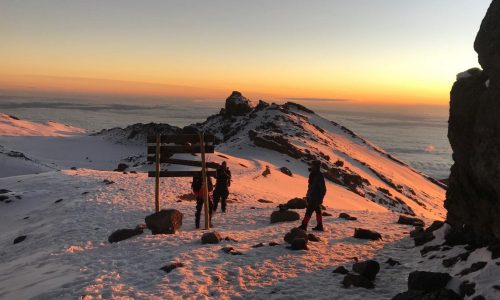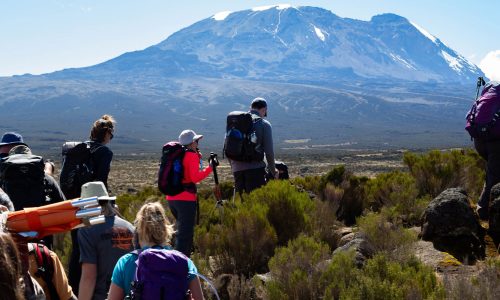6 Days Kilimanjaro Climbing Machame Route
Tour Overview
Because of its acclimatization profile, the Machame route is the best choice for those who only have six days to climb Kilimanjaro. The Machame route, in comparison to other six-day routes, exposes the climber to higher elevations sooner (day three), allowing the body to adapt to altitude sooner. However, in order to tackle the challenging elevation gains and losses on this route, one must be in good physical condition.
The Machame variation, which lasts six days, is a difficult trek. Day four, in particular, when combined with day five, creates a very demanding schedule. The fourth day is spent hiking from Barranco to Barafu. The very long and strenuous summit day begins around midnight, after dinner and a partial night’s sleep. The 6-day Machame route entails 19–24 hours of strenuous walking at a high altitude, with only 4-6 hours of sleep.
Day to Day Itinerary
Day 1: Machame Gate (1490m) – Machame Camp (2980m)
- Time spent hiking: 7 hours
- Approximate distance: 18 kilometers
- Montane forest is the habitat of this species.
After an early breakfast at your hotel, you will be picked up and driven to Machame Village from Arusha (1400m). You can purchase mineral water in the village and will be given a packed lunch. Depending on road conditions, you can drive from the village to the Machame gate, but if not, the muddy 3 km walk will take about an hour.
You begin your ascent and enter the rainforest almost immediately after registering at the gate office. There’s a good chance of rain in the forest, which will turn the trail soggy, muddy, and slippery. You’ll stop for a welcome lunch break about halfway through and arrive at the Machame camping area late in the afternoon.
Your porters (who arrived at the campsite much earlier than you) will have already set up your tent when you arrive. Before you retire to your tent for the night, the porters will boil drinking and washing water and the cook will prepare dinner. At this campsite, nighttime temperatures can already be below freezing.
Day 2: Shira camp (2980m) – Machame camp (2980m) (3840m)
- Time spent hiking: 6 hours
- Approximate distance: 9 km
- Moorland is its natural habitat.
You get up early at Machame camp and climb for an hour or so to the top of the forest, then walk for two hours through the moorland zone at a gentler gradient. You continue up a rocky ridge onto the Shira plateau after a quick lunch and rest. By now, you should be able to see the Western Breach with its magnificent glaciers from an easterly direction. You are now due west of Kibo and will arrive at the Shira campsite at 3 840m after a short hike. Before serving dinner, the porters will boil drinking and washing water. The night will be even colder at this exposed camp than the previous night, with temperatures falling well below freezing.
Day 3: Shira (3840m) to Lava Tower (4630m) to Barranco camp (at 3950m)
- Time spent hiking: 7 hours
- The distance is approximately 15 kilometers.
- Semi-desert habitat
After about a 5-hour walk, the route turns east into a semi-desert and rocky landscape surrounding Lava Tower, where you will reach an altitude of 4630m. Before ascending the rocky scree path to Lava Tower, lunch is served in a designated area (4630m).
This is by far the most difficult day so far. It is usually around this point that some climbers begin to experience symptoms such as breathlessness, irritability, and headaches for the first time. After lunch, you descend nearly 680 meters to the Barranco camping area, and the true acclimatisation benefit of this day becomes apparent when you reach the high altitude of 4600 meters at Lava Tower.
The descent to Barranco camp takes about 2 hours and provides excellent photographic opportunities of the Western Breach and Breach Wall. While you wait for your dinner to be prepared, the camp is located in a valley below the Breach and Great Barranco Wall, which should provide you with a memorable sunset.
Day 4: Barranco camp (3950m)-Barafu camp (4550m)
- Time spent hiking: 7 hours
- The distance is approximately 13 kilometers.
Alpine desert as a habitat
After spending the night at the Great Barranco Wall (an intimidating sight at first), you climb this impressive-looking obstacle, which usually turns out to be easier than you anticipated. When you reach the top, just below the Heim Glacier, you realize how stunning Kilimanjaro is.
The route then descends through the Karanga Valley, passing through ridges and valleys on its way to join the Mweka route. This is the preferred descent route from the summit, so keep it in mind. Turn left up the ridge and you’ll arrive at Barafu Hut in about an hour.
Because there is no water at Barafu camp, the last water stop on the route is the Karranga Valley. The Swahili word “barafu” means “ice,” and it is a desolate and inhospitable camping spot. The tents are pitched on a narrow, stony, and dangerous ridge, completely exposed to the constant gales. To avoid any mishaps, make sure you familiarize yourself with the terrain before it gets dark.
The summit is now 1345 meters higher, and you’ll finish the climb that night. For your summit attempt, prepare your equipment, ski stick, and thermal clothing. This should include replacing your headlamp and camera batteries, as well as making sure you have a spare set on hand. Carry your water in a thermal flask to prevent it from freezing. Go to bed around 19h00 and try to catch up on some much-needed rest and sleep.
Day 5: Barafu Camp (Summit Attempt) (4550m) – Mweka (5895m) – Uhuru Peak (5895m) (3100m)
Time spent hiking: 8 hours to reach Uhuru Peak, 7–8 hours to descend to Mweka.
- Distance: Approximately 7 kilometers of ascent and 23 kilometers of descent
- Stone scree and an ice-capped summit are the habitats.
You’ll get up around 23h30 and shuffle off into the night after some tea and biscuits. You’ll ascend through heavy scree to Stella Point on the crater rim in a north-westerly direction. This 6-hour walk to Stella Point is the most mentally and physically demanding on the route for many climbers.
You’ll take a short break at Stella Point (5685m) and be rewarded with the most spectacular sunrise you’ll ever see (weather permitting). On your 2-hour ascent to Uhuru Peak from Stella Point, you will almost certainly encounter snow. The amount of time you spend on the summit will be determined by the weather. Stopping here for too long will make it difficult to restart due to the cold and fatigue. Take pride in your accomplishment and remember this day for the rest of your life.
It takes about 3 hours to return to Barafu from the summit. You’ll take a well-deserved but brief break here before gathering the rest of your belongings. The trail is not difficult and will take you through the moorland and into the forest via a rock and scree path. The camp is located in the upper forest, so expect mist or rain in the late afternoon. Dinner will be prepared, as well as washing water.
Day 6: Mweka camp (3100m) – Mweka Gate (1980m)
- Hiking time: 3 hours Distance: 15 kilometers
- Forest habitat
Your team will have a big celebration with dancing and singing after a well-deserved breakfast. You will present your suggestions to the guide, assistant guides, chef(s), and porters here on the mountain. You will return to Mweka Gate after celebrating for three hours.
To receive a certificate of completion from the National Park, all hikers must sign their names. Hikers who reach Stella Point (5685m) are awarded green certificates, while those who reach Uhuru Peak (5895m) are awarded gold certificates. Hikers will descend into Mweka village for 1 hour after receiving certificates (3 kilometers). You’ll be served a hot lunch before returning to Moshi for some much-needed rain and more celebrations.
Related Trekking Packages

6 Days Marangu Route

6 Days Lemosho Route

6 Days Machame Route

6 Days Umbwe Route

7 Days Rongai Route
Included
- Park fees (For non-residents)
- All activities (Unless labeled as optional)
- All accommodation (Unless listed as upgrade)
- A professional driver/guide
- All transportation (Unless labeled as optional)
- All Taxes/VAT
- Roundtrip airport transfer Meals
(As specified in the day-by-day section) - Drinks (As specified in the day-by-day section)
Not Included
- International flights (From/to home)
- Additional accommodation before and at the end of the tour
- Tips (Tipping guideline US$20.00 pp per day)
- Personal items (Souvenirs, travel insurance, visa fees, etc.)
- Government-imposed increase of taxes and/or park fees